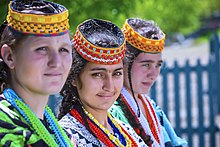Our website is made possible by displaying online advertisements to our visitors.
Please consider supporting us by disabling your ad blocker.
Kalash people
 Kalash girls photographed in April 2016 | |
| Total population | |
|---|---|
| c. 7,466[1] (only includes those who speak Kalasha as their mother tongue) | |
| Regions with significant populations | |
| Kalasha Valleys, Chitral District, Pakistan | |
| Languages | |
| Kalasha, Khowar | |
| Religion | |
| Majority Islam[2] Minority Animism and ancestor worship[a] with elements of ancient Indo-Iranian (Vedic- or Hindu-like) religion[b] [3][2] | |
| Related ethnic groups | |
| Nuristanis, other Indo-Aryan peoples |
The Kalash (Kalasha: کالؕاشؕا, romanized: Kaḷaṣa), or Kalasha, are a small Indo-Aryan[c] indigenous (minority) people residing in the Chitral District of the Khyber-Pakhtunkhwa province of Pakistan. The term is also used to refer to several distinct Nuristani speaking people, including the Väi, the Čima-nišei, the Vântä, plus the Ashkun- and Tregami-speakers.[web 1]
According to one Kalash tradition, their ancestors migrated to Chitral Valley from Nuristan Province, Afghanistan or a location further south,[web 2][4] called "Tsiyam" in their folk songs and epics,[5] and possibly located near Jalalabad and Lughman in Afghanistan. Another tradition claims descent from the armies of Alexander who were left behind from his armed campaign, though no evidence exists for him to have passed the area.[web 3][web 4][d][6]
During the Muslim rule in Chitral in the 14th century most of the Kalash gradually converted to Islam, except a small number of them who upheld their religion and customs, but they were restricted to the Kalasha Valleys of Bumburet, Rumbur and Birir. Despite the increasing Muslim population that converted the majority of the Kalash to a minority even in these valleys as well, their survival with their ancient religious and cultural traditions is a matter of significance.[2]
Prior to the 1940s the Kalash had five valleys, the current three as well as Jinjeret kuh and Urtsun to the south. The last Kalash person in Jinjeret kuh was Mukadar, who passing away in the early 1940s found himself with no one to perform the old rites. The people of Birir valley just north of Jinjeret came to the rescue with a moving funeral procession that is still remembered fondly by the valleys now converted Muslim Kalash, firing guns and beating drums as they made their way up the valley to celebrate his passing according to the old custom.[7]

The Kalash of Urtsun valley had a culture with a large Kam influence from the Bashgul Valley. It was known for its shrines to Waren and Imro, the Urtsun version of Dezau, which were visited and photographed by Georg Morgenstierne in 1929 and were built in the Bashgul Valley style unlike those of other Kalash valleys. The last Shaman was one Azermalik who had been the Dehar when George Scott Robertson visited in the 1890s. His daughter Mranzi who was still alive into the 1980s was the last Urtsun valley Kalash practising the old religion. She had married into the Birir Valley Kalash and left the valley in the late 1930s when the valley had converted to Islam. Unlike the Kalash of the other valleys the women of Urtsun did not wear the Kup'as headdress but had their own P'acek, a headress worn at casual times, and the famous horned headress of the Bashgul valley, which was worn at times of ritual and dance.[8] George Scott Robertson put forth the view that the dominant Kafir races like the Wai were refugees who fled to the region. The Kafirs are historically recorded for the first time in 1339.[9]
They are considered unique among the people of Pakistan,[web 2][web 1][10] and form Pakistan's smallest ethnoreligious group,[web 5] practising what authors consider as a form of animism and ancestor worship[a] with elements of Indo-Iranian (Vedic- or Hindu-like) religion.[b]
- ^ "Pakistan 2023 Census" (PDF). Archived from the original (PDF) on 23 July 2024.
- ^ a b c Cite error: The named reference
Zaheer-ud-Dinwas invoked but never defined (see the help page). - ^ Ahmed 1986, p. 23–28.
- ^ Nicolaisen, Johannes; Yde, Jens (1963). Folk: dansk etnografisk tidsskrift. Dansk etnografisk forening.
- ^ East and West. Istituto italiano per il Medio ed Estremo Oriente. 1992.
- ^ Cacopardo, Augusto (2011). "Are the Kalasha Really of Greek Origin? The Legend of Alexander the Great and the Pre-Islamic World of the Hindu Kush". Acta Orientalia. 72: 47–92. doi:10.5617/ao.4847.
- ^ Cacopardo, Alberto (December 1992). "The Other Kalasha. A Survey of Kalashamun-Speaking People in Southern Chitral. Part III: Jinjeret Kuh and the Problem of Kalasha Origins". East and West. 42 (2/4): 333–375.
- ^ Cacopardo, Augusto (December 1991). "The Other Kalasha. A Survey of Kalashamun-Speaking People in Southern Chitral. Part II: The Kalasha of Urtsun". East and West. 41 (1/4): 331–350.
- ^ Adamec, L.W., ed. (1985). Historical and Political Gazetteer of Afghanistan. Vol. 6. Akademische Druck- u. Verlagsanstalt Graz. p. 349.
He identifies them more particularly with the Gandhari, that is to say, the former inhabitants of what is now known as the Mohmand country.
- ^ Cacopardo 2016, p. 28.
Cite error: There are <ref group=lower-alpha> tags or {{efn}} templates on this page, but the references will not show without a {{reflist|group=lower-alpha}} template or {{notelist}} template (see the help page).
Cite error: There are <ref group=web> tags on this page, but the references will not show without a {{reflist|group=web}} template (see the help page).
Previous Page Next Page


